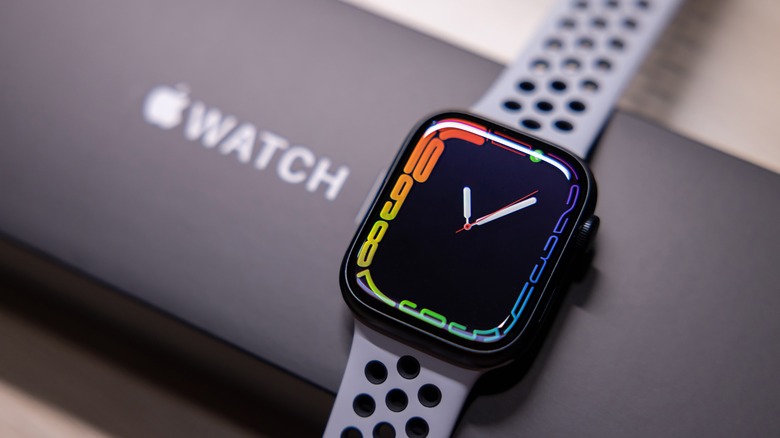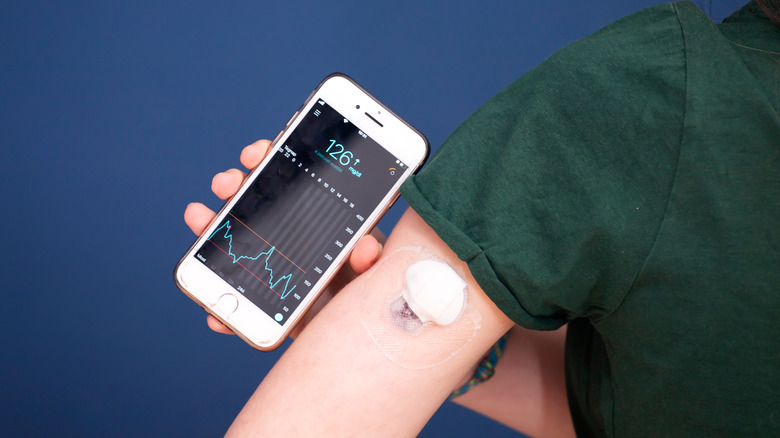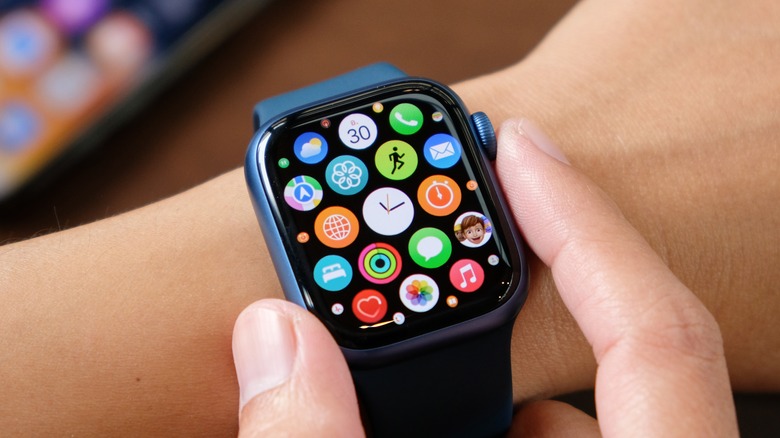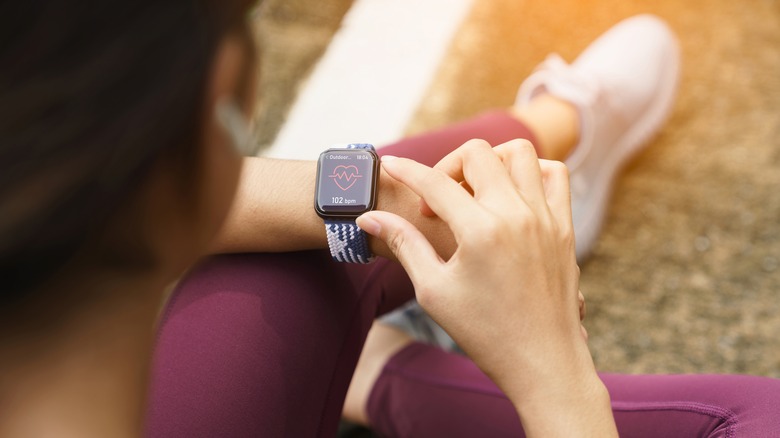How To Use Your Apple Watch As A Glucose Monitor
The Apple Watch packs a bunch of features into an incredibly tiny package, boasting seemingly magical capabilities like ECG results and A-Fib detection. One of the health features it doesn't have at the time of writing is a blood glucose monitor, which is unfortunate for the many Apple users who have diabetes — though there have certainly been rumors about a blood glucose tracking feature arriving at some point in the future. That doesn't mean Apple's smartwatch isn't useful to diabetics, however.
The market is full of various glucose-monitoring devices, including some that continuously monitor the user's blood sugar levels to alert them about any risky fluctuations. The latest and greatest among these devices include compatibility with the smart devices we carry around every day, including the Apple Watch. When used together, the Apple Watch serves as the portal through which you can easily view your blood glucose measurements and receive alerts if the levels grow dangerously high or fall too low.
You'll need a compatible glucose monitor
Though the Apple Watch can't monitor your blood glucose levels on its own, there are some glucose monitors on the market that are able to send alerts to your iPhone. This vital feature warns diabetics about an impending high or low blood glucose emergency, giving them time to get help. In some cases, these alerts can also be delivered to an Apple Watch — and that may be a life-saving capability, as outlined by CNET's Justin Eastzer. In a November 2022 editorial, Eastzer revealed that an alert from his continuous glucose monitor sent to his Apple Watch woke him up in the middle of the night just in time for him to get some sugar in his system before he passed out from dangerously low blood glucose levels.
As Eastzer's story revealed, a diabetic may be only minutes away from a life-threatening health situation, which is why getting a real-time alert is so important. Because an Apple Watch is strapped on your wrist, it may prove more useful than an alert sent to a phone. In order to get the alerts on your smartwatch, however, you'll need a glucose monitor that is compatible. In Eastzer's case, it appears he was using a Dexcom G6. However, there are a few other options on the market, too, such as the Eversense CGM.
If you want to use your Apple Watch as a way to record your blood glucose data — but not necessarily as a way to get real-time alerts — there are some other options from companies like One Drop. Unlike a continuous glucose monitor, however, these systems won't proactively monitor your blood sugar levels and send warnings to the smartwatch.
How to use the Apple Watch with a continuous blood glucose monitor
Because a continuous blood glucose monitor is a medical device, it is important to talk with your doctor about what it is you're looking for. In some cases, you may need to get your doctor to prescribe the CGM, which means you may need to specifically request a prescription for a model that includes Apple Watch support. As well, you may need to make an appointment for the doctor to insert the product's sensor so that it is able to continuously monitor your blood glucose levels. During the same appointment, your medical provider should provide training on how to use the device.
The exact process of setting up the continuous glucose monitor so that it delivers alerts to an Apple Watch will vary depending on the product. In the broadest sense, you'll likely need to install the product's companion app on your iPhone and adjust its settings so that you get the kinds of alerts you want, such as emergency alerts about dangerous blood sugar fluctuations. Because it is critical to set up the device properly, you should carefully read the instructions included with the product and get in touch with the manufacturer's customer support team with any specific questions and for help setting up the system if necessary. The instructions used for setting up one product may not be applicable to a different product.
Can the Apple Watch natively monitor blood glucose?
At the time of writing, the Apple Watch Series 8 (the current-generation model) and older are not able to monitor blood glucose levels on their own. This may change in the future, but at this time, you'll need to use a separate glucose monitor that is able to communicate with the Apple Watch wirelessly. That doesn't mean the Apple Watch isn't worth owning, however, as the device packs many other health features — and some of them have even saved lives.
Apple's smartwatch is particularly useful for individuals who suffer from a heart rhythm disorder called Atrial Fibrillation (A-Fib), which increases one's risk of experiencing a stroke, among other things. The Apple Watch uses a combination of hardware and software to monitor A-Fib episodes and record the data, which can then be given to the patient's doctor as a long-term look at how the condition manifested over the recent past.
Depending on the Apple Watch model, users can also get alerts when their heart rate is unusually elevated, take ECG measurements, monitor their blood oxygen levels, send emergency alerts if they fall, and even get an alert if the wearable detects low cardio fitness metrics. You can check which features your Apple Watch offers over on Apple's Healthcare web page.



